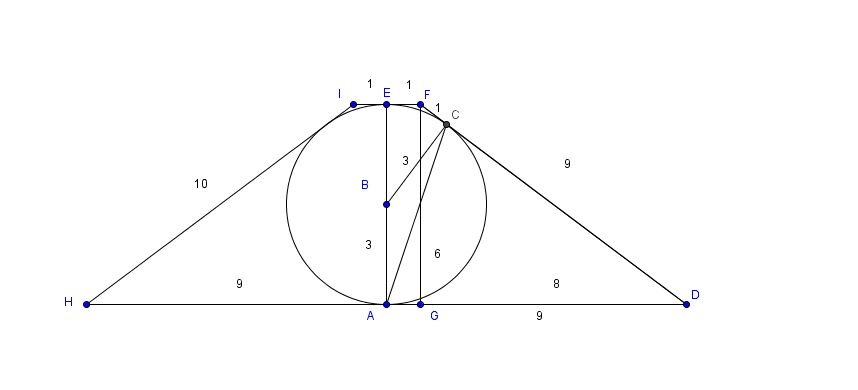There may be a much easier way to do this, but we can find the volume of the frustum by creating a cross-sectional kite .......the sphere will have a circular cross-section and the frustum will have a cross-sectional trapezoid

First......since the sphere is tangent to the frustum at both the top and bottom bases, the frustum height is = 6
So.....we can create a 6-8-10 Pythagorean right triangle DGF as shown in the illustration - with one leg of 6 - (GF) - one leg of 8 - (DG) - and the slant height - (DF) -forming the hypotenuse........the cosine of angle FDG ( at the bottom right vertex of the frustum ) = 8/10 = 4/5
Now......the radii of the circle will form kite ABCD
Connect AC......angle ABC will be supplementary to angle FDG......so its cosine = -4/5
And because DA and DC are tangents drawn from the same point D, they are equal
And we can use the Law of Cosines to find AC
Note: AB and BC are radii of the circle
AC^2 = AB^2 + BC^2 - 2(AB)(BC)(cos ABC)
AC^2 = 3^2 + 3^2 - 2(3)(3) (-4/5)
AC^2 = 18 + 72/5
AC^2 = [ 90 + 72] / 5
AC^2 = [ 162 / 5 ]
And Using the Law of Cosines once more, we can find the lenths of DA and DC.....let their lengths = x......and we have
AC^2 = x^2 + x^2 - 2 (x^2)cos(CDA)
[ 162 / 5 ] = 2x^2 - 2x^2 [ 4/5 ]
[162/ 5 ] = 2x^2 [ 1 - 4/5]
[ 162 / 5 ] = 2x^2 [ 1/5]
162 = 2x^2
x^2 = 81
x = 9 = DA = DC
But DA = radius of the bottom base of the frustum
And since DC = 9.....then CF = FD - DC = 10 - 9 = 1
But CF = FE since they are tangents drawn from the point F
And FE = radius of the top base of the frustum
So.....using the fomula for the volume of a frustum, we have
V = pi * GF * ( DA^2 + DA*FE^2 + FE^2 ) / 3
Where
GF = frustum height
DA = radius of bottom base
FE = radius of top base
So we have
pi * ( 6) * ( 9^2 + 9 * 1 + 1^2 ) / 3 =
pi (6) ( 81 + 9 + 1 ) / 3 =
pi (6) (91) / 3 =
2 * 91 pi =
182 pi units^3


